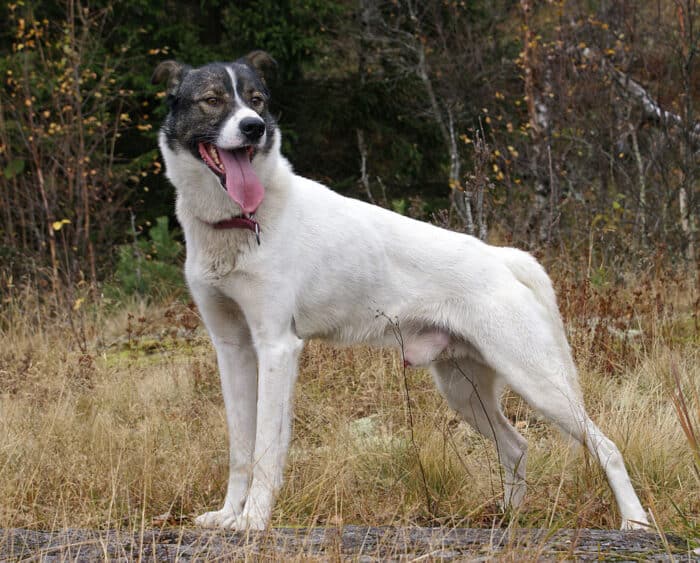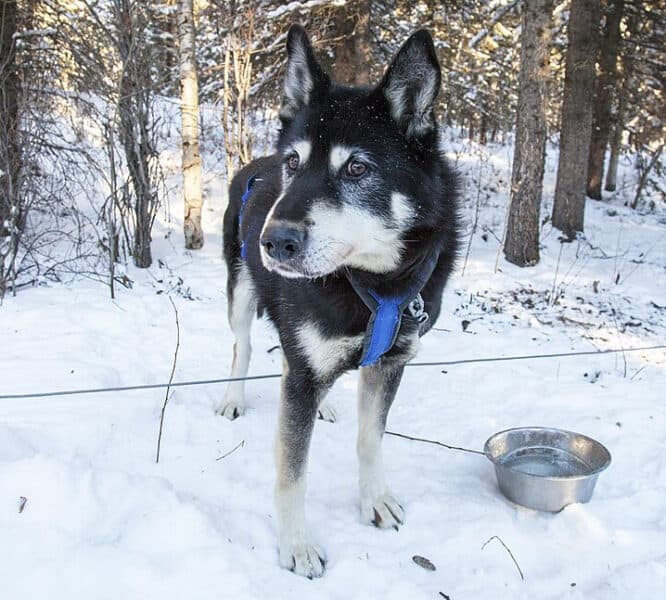The Alaskan Husky is a renowned breed, celebrated for its keen intelligence and friendly nature. Often medium to large in size, this breed possesses a unique blend of physical attributes that make it easily recognizable.
While it’s not overly aggressive, its amiable demeanor makes it a favorite among families. Its stature and characteristics are a testament to its Arctic lineage, and it enjoys particular popularity in colder regions.
Alaskan Huskies are Highly Energetic: This breed requires regular exercise and mental stimulation to keep them happy and healthy.
Grooming Needs are Moderate: While they have a thick double coat that sheds, regular grooming can manage this and keep their coat healthy.
Intelligent and Trainable: Alaskan Huskies are smart dogs that respond well to consistent training, but they can get bored easily due to their intelligence.
Health Concerns to Watch For: While generally healthy, they can have predispositions to conditions like hip dysplasia or progressive retinal atrophy.
Mixed Breeds are Popular: Alaskan Huskies are often mixed with other breeds, resulting in unique combinations that carry traits from both parents.
Alaskan Husky Breed – Quick Facts
| Feature | Description |
|---|---|
| Size | Medium to Large; Height: 23-26 inches (58-66 cm) |
| Weight Range | 40-60 lbs (18-27 kg); Slight variation between males and females |
| Predominant Colors | Black, Gray, Sable, Red |
| Fur Length and Type | Medium; Straight |
| Lifespan | 10-15 years |
| Activity Level | High |
| Intelligence Level | High |
| Ease of Training | Average |
| Good with Kids | Yes |
| Training Requirements | Standard |
| Known Health Issues | Hip dysplasia, Cataracts, Thyroid disorders |
Physical Characteristics of an Alaskan Husky
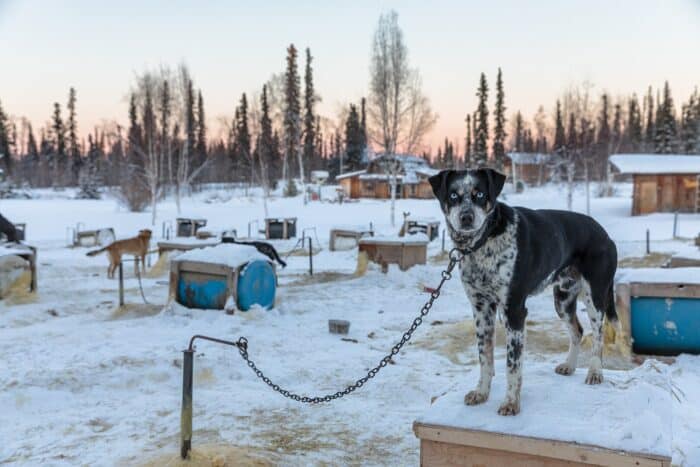
The Alaskan Husky stands tall with a medium to large build. These dogs typically weigh between 40 and 60 pounds, with males generally being slightly larger than females.
Their body structure is lean yet muscular, making them apt for endurance activities, especially in cold environments.
Their coat is of medium length and straight. While they come in various colors, some of the most common ones include black, gray, sable, and red.
Beyond just their coat color, their head holds some distinguishing features. The Alaskan Husky has a moderately sized muzzle, not too long or short.
Their ears stand erect and have a triangular shape, always alert and listening.
When you look into their eyes, you often see expressions of curiosity and intelligence. Some Alaskan Huskies even have heterochromia, where each eye is a different color.
Another distinct feature of this breed is its gait. When an Alaskan Husky moves, it does so with grace and power. Their strides are long and purposeful, making them efficient runners.
Whether they’re trotting or running at full speed, their movement exudes strength and stamina.
Alaskan Husky Temperament & Personality
The Alaskan Husky is best described as a blend of energy and amiability. They possess a vibrant spirit, often eager to explore and play. However, their energy does not translate into hyperactivity. Instead, they display a controlled enthusiasm that’s both engaging and endearing.
When it comes to interactions, the Alaskan Husky is generally sociable. They get along well with people, including strangers, showcasing a friendly demeanor.
This breed also tends to be good with other dogs, often enjoying canine companionship. However, their interaction with smaller animals might need supervision, given their prey drive.
Training an Alaskan Husky is a rewarding experience. They are quick learners, showcasing a good deal of focus during training sessions. Their high intelligence level means they can grasp new commands relatively quickly.
However, it’s essential to keep the training sessions engaging, as their curious nature might make them lose interest if the activity becomes repetitive.
The Alaskan Husky has a notable energy level. Daily exercise is crucial to keep them physically and mentally stimulated. This breed thrives in active households, where they can expend their energy through play and exploration.
They are also adaptable and can fit well into various living situations. When it comes to family life, they’re generally excellent with children and other pets, making them a delightful addition to many homes.
What Does The Ideal Home For an Alaskan Husky Look Like?
The Alaskan Husky is a breed that thrives in spaces where it can move freely. Ideally, a home with a large backyard would suit them best. This space allows them to play, explore, and expend their boundless energy. If the yard is present, secure fencing is crucial to prevent them from wandering off, given their curious nature.
In terms of family settings, the Alaskan Husky fits well into diverse households. They can be a great companion for families with children, given their gentle and playful nature. However, supervision might be necessary when they interact with very young kids.
For households with elderly members, the Alaskan Husky’s friendly demeanor is a plus, though it’s essential to ensure that their energy doesn’t become overwhelming.
Exercise is a significant aspect of the Alaskan Husky’s life. Therefore, proximity to open spaces like parks or trails can be beneficial. These areas provide an excellent environment for activities like running or playing fetch.
Off-leash areas are particularly appreciated, allowing them to run freely and socialize with other dogs.
Can Alaskan Huskies be left alone?
The Alaskan Husky has a moderate tolerance for solitude. While they value companionship and enjoy being around their human family, they can manage short periods alone without much distress.
However, prolonged isolation can lead to feelings of loneliness or boredom for this breed. In some cases, this can manifest as separation anxiety or even result in destructive behaviors.
If an owner needs to leave their Alaskan Husky alone regularly, it’s crucial to ensure the dog has adequate mental and physical stimulation during these times. This can be achieved through toys, puzzle feeders, or even leaving the radio on for background noise.
Setting up a routine and providing them with ample exercise before being left alone can help reduce potential stress.
Ideal Owner for an Alaskan Husky
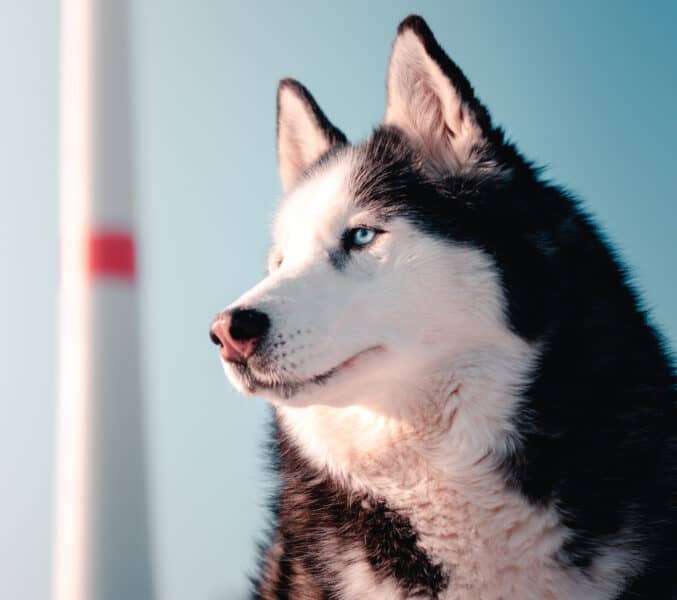
The Alaskan Husky, with its lively disposition and intelligence, requires an owner who can match its enthusiasm and commitment.
Ideally, someone with prior dog-handling experience would be well-suited, as they would be familiar with the nuances of training and the breed’s specific needs. However, dedicated first-time dog owners can also provide a loving home, as long as they are willing to invest the time in understanding and meeting the breed’s requirements.
Lifestyle plays a significant role in determining compatibility. Active individuals or families who enjoy outdoor activities would be a good match for the Alaskan Husky. Given the breed’s high energy levels, owners should be prepared for regular exercise sessions, be it long walks, hikes, or playtime in the backyard.
Training is an essential aspect of the Alaskan Husky’s life. They respond best to consistent training methods that are positive and engaging. The owner should be willing to invest time in both basic obedience training and more advanced activities, depending on the dog’s interest.
In terms of time commitment, the ideal owner should be prepared to spend quality time with their Alaskan Husky daily. This breed thrives on companionship and benefits from regular interaction, be it through play, training, grooming, or simply lounging together.
Are Alaskan Huskies good with kids?
Alaskan Huskies are generally good with children. Their friendly and gentle nature makes them a popular choice for families. They are often patient, which means they can tolerate the playful antics of kids. Moreover, their energetic disposition aligns well with the spirited nature of children, making them great playmates.
However, it’s essential to teach children how to interact with dogs appropriately. They should understand the importance of not disturbing the dog while it’s eating or sleeping and avoiding rough play. While Alaskan Huskies are patient, like all dogs, they have their limits. Ensuring respectful interaction is key to fostering a harmonious relationship between the dog and children.
It’s also beneficial to supervise interactions between younger children and the dog, especially initially, to ensure safety for both parties. With the right guidance and supervision, Alaskan Huskies can form deep bonds with kids, offering companionship and affection.
Are Alaskan Huskies aggressive?
Generally, Alaskan Huskies are not known for being aggressive. They have a friendly disposition and often showcase a welcoming nature towards both people and other animals. However, like all breeds, individual personalities can vary, and certain circumstances or triggers might elicit defensive behaviors.
It’s essential to understand that any signs of aggression often stem from fear, past traumas, or a lack of proper socialization. Early socialization is crucial for Alaskan Huskies. Exposing them to various environments, people, animals, and sounds during their formative months can significantly reduce the chances of aggressive tendencies in adulthood.
Owners should also be aware of their dog’s body language. Signs of discomfort, such as growling, raised hackles, or baring teeth, should be taken seriously. In situations where an Alaskan Husky shows discomfort or aggression, it’s essential to remove them from the triggering environment and consult a professional to address and manage the behavior.
How Popular Is This Breed?
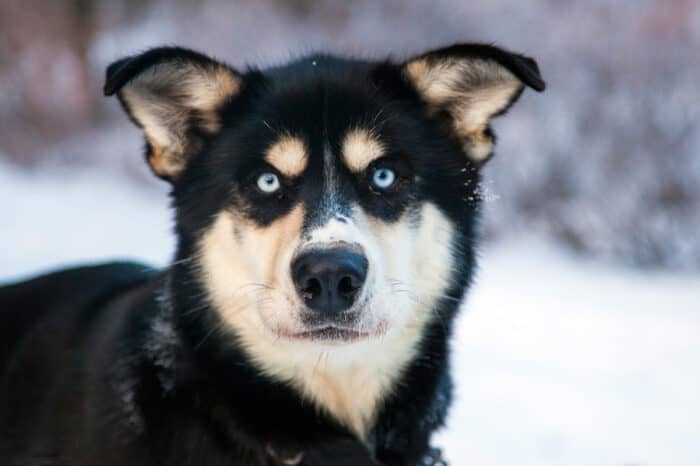
The Alaskan Husky enjoys a notable degree of popularity, especially among those who appreciate its unique blend of endurance, intelligence, and friendly demeanor. Historically, this breed has been invaluable for sled racing and transportation in colder regions, which has contributed to its recognition and admiration.
In the USA, the Alaskan Husky is well-regarded, especially in states with colder climates. Their ability to thrive in low temperatures and snowy conditions makes them a favorite in northern regions. Moreover, their participation in famous sled dog races, like the Iditarod, has elevated their status and brought them into the national spotlight.
Globally, the breed’s popularity varies. While they might not be as universally recognized as some other breeds, in areas where sled dog racing or activities are prevalent, the Alaskan Husky is highly esteemed.
Alaskan Husky Grooming
Grooming plays a vital role in maintaining the health and appearance of an Alaskan Husky. With their medium-length coat, regular grooming ensures they remain clean, comfortable, and free from potential skin issues.
Brushing is a fundamental aspect of their grooming routine. It helps in removing loose fur, dirt, and potential debris. For the Alaskan Husky, a weekly brushing session is typically sufficient, though during shedding seasons, more frequent brushing might be necessary. Using a quality slicker brush or a deshedding tool can help in effectively managing their coat.
Bathing the Alaskan Husky doesn’t need to be a frequent affair. Given their coat’s natural ability to repel dirt, baths can be given once every few months or when the dog gets particularly dirty. When bathing, it’s essential to use a dog-specific shampoo that’s gentle on their skin. Thoroughly rinsing and ensuring the coat is entirely dry post-bath is crucial.
While their coat is relatively low-maintenance, other aspects of grooming, like nail trimming, ear cleaning, and dental care, should not be overlooked. Regular nail trims prevent overgrowth and potential discomfort. Cleaning their ears helps in preventing infections, and maintaining dental hygiene ensures good oral health.
Do Alaskan Huskies shed?
Yes, Alaskan Huskies do shed. They possess a double coat, comprising a dense undercoat and longer guard hairs. This coat is designed to provide insulation against cold temperatures, but it also means they go through shedding cycles. Alaskan Huskies typically shed year-round, with two major shedding seasons—once in the spring and once in the fall. During these times, they “blow” their undercoat, which can result in a significant amount of loose fur.
To manage shedding and ensure cleanliness in the living environment, regular brushing is paramount. Brushing not only helps in removing the loose fur but also aids in distributing natural oils across the skin, promoting a healthier coat. Investing in a good-quality deshedding tool can make this process more efficient, especially during peak shedding seasons.
Alaskan Husky Diet: What Do They Eat?
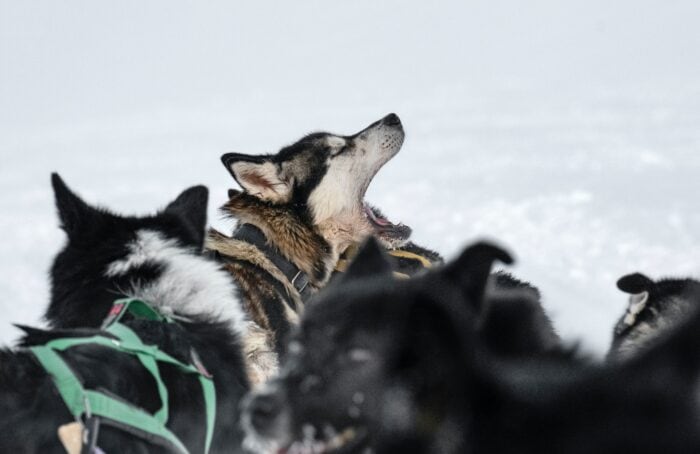
The Alaskan Husky’s diet should be tailored to its specific needs, considering its high energy levels and active lifestyle. A balanced diet is crucial for this breed to maintain optimal health, muscle tone, and energy.
The foundation of their diet is high-quality dog food. Whether you choose kibble, wet food, or a raw diet, ensure it’s rich in protein and has the right balance of fats and carbohydrates. Given their active nature, they require a diet that can sustain their energy demands, so foods rich in lean meats like chicken, beef, or fish are ideal.
While many Alaskan Huskies thrive on commercial dog foods, some might have specific dietary sensitivities or allergies. Ingredients like grains, certain proteins, or artificial additives can trigger reactions in some dogs. If you notice symptoms like itching, digestive upset, or skin issues, consulting a vet and considering a hypoallergenic diet might be necessary.
Treats are a delightful addition to their diet but should be given in moderation. Opt for healthy treats that align with their dietary needs. Avoid treats high in sugars, salts, or artificial additives.
How to Feed an Alaskan Husky
Feeding an Alaskan Husky appropriately ensures they get the nutrients they need while maintaining an ideal weight. Establishing a routine is key. Consistent feeding times help in regulating their digestive system and set a predictable schedule for them.
Use a sturdy, easy-to-clean bowl for their meals. Some owners opt for elevated bowls, which can aid in digestion and reduce the strain on the dog’s neck and back, especially for larger individuals.
While determining the portion size, consider the dog’s age, weight, activity level, and the caloric content of the food. Always refer to the feeding guidelines provided on the dog food packaging, but remember that these are general recommendations. Adjustments might be necessary based on the dog’s individual needs.
How Much to Feed an Alaskan Husky
Determining the right amount of food for an Alaskan Husky depends on various factors. Their age, weight, activity level, and the type of food they’re consuming all play a role.
For adult Alaskan Huskies with a moderate activity level, the general guideline is to feed about 1 to 2 cups of high-quality dry dog food, split into two meals per day. However, for those involved in intense activities or sports like sledding, the amount might increase to sustain their energy requirements.
Puppies have different dietary needs. They usually require more frequent meals – three to four times a day. As they grow, the meal frequency can be reduced, and the portion sizes increased.
Senior dogs might have a reduced metabolism, which means they could require slightly less food than their younger counterparts. However, they might also have specific dietary needs, especially if they suffer from age-related health issues.
Health Considerations
The Alaskan Husky, like all breeds, has certain health considerations that potential and current owners should be aware of. Being informed helps in early detection, prevention, and management of these concerns.
Hip dysplasia is a common issue in many dog breeds, including the Alaskan Husky. This condition affects the hip joint, leading to pain and, in severe cases, lameness. Regular check-ups and maintaining an ideal weight can help in managing this condition.
Another concern is progressive retinal atrophy (PRA). This genetic condition affects the eyes, leading to gradual vision loss. Regular eye check-ups can help in early detection.
Zinc deficiency can also affect Alaskan Huskies. This trace mineral is essential for various bodily functions, and its deficiency can lead to symptoms like hair loss, skin issues, and lethargy.
The average lifespan of an Alaskan Husky ranges from 12 to 15 years. As they age, they might face age-related issues like arthritis, dental problems, and reduced energy levels. Regular vet visits, a balanced diet, and appropriate exercise can support them through their senior years.
Preventative healthcare is essential. Keeping up with a regular vaccination schedule, ensuring protection against pests like fleas, ticks, and worms, and routine vet check-ups are vital for the Alaskan Husky’s overall health.
Environmental factors can also affect their health. As they are more suited to colder climates, they might face challenges in extremely hot conditions. Ensuring they have a cool, shaded place in the summer and access to fresh water at all times is crucial.
How much exercise do Alaskan Huskies need?
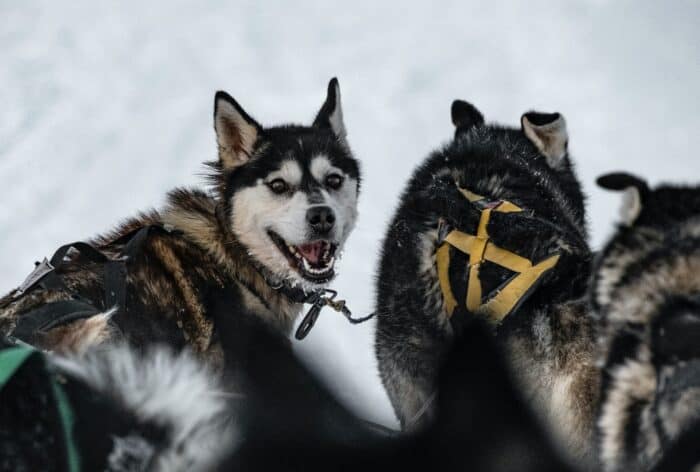
Exercise is fundamental for an Alaskan Husky’s physical and mental well-being. Known for their stamina and energy, they require regular, vigorous activity to keep them healthy and content.
On average, an Alaskan Husky should get at least one to two hours of exercise daily. This can be split into multiple sessions, encompassing activities like walking, running, and playtime. Due to their sled-dog heritage, they particularly excel in endurance activities. Many Alaskan Huskies enjoy activities like hiking, jogging alongside a bike, or even participating in dog sports like agility or mushing.
Mental stimulation is equally important. Training sessions, puzzle toys, and interactive games can keep their minds sharp and engaged. This not only reinforces positive behaviors but also helps in preventing undesirable actions born out of boredom.
While they are versatile and adapt well to various exercises, it’s essential to consider their comfort and safety. In hotter climates, exercise during the cooler parts of the day, such as early morning or late evening, to prevent overheating. Always ensure they have access to fresh water during and after physical activity.
Alaskan Husky Training
Training is a crucial aspect of raising a well-behaved and sociable Alaskan Husky. These dogs are intelligent and eager to please, making them relatively receptive to training efforts. However, consistency and patience are key to achieving the best results.
Starting training early is beneficial. As puppies, Alaskan Huskies are more malleable and can easily pick up on commands and behaviors. Basic commands like “sit,” “stay,” and “come” should be introduced initially. Positive reinforcement, using treats and praise, encourages them to repeat desired behaviors.
Socialization is another significant aspect of training. Exposing the Alaskan Husky to various environments, people, and other animals from a young age fosters well-rounded social behaviors. Regular trips to dog parks, walks in different settings, and interactions with diverse groups of people and animals can help in this.
While they generally have a good disposition, some Alaskan Huskies can exhibit specific behavioral issues, such as digging or a high prey drive. Recognizing these tendencies early on and addressing them through training and environmental adaptations can prevent them from becoming problematic habits.
For those interested in advanced training, Alaskan Huskies can excel in various dog sports. Their agility, endurance, and intelligence make them suitable candidates for activities like agility courses, obedience competitions, and even service dog training.
House training is another essential aspect. Establishing a routine and being consistent with potty breaks can help in quick and efficient house training. Using positive reinforcement when they do their business outside and avoiding punishment for accidents inside the house can make the process smoother.
Are Alaskan Huskies easy to train?
Alaskan Huskies are generally known for their intelligence and eagerness to learn, which can make training them a more straightforward task compared to some other breeds. Their background as sled dogs means they are accustomed to working in teams and taking commands.
However, their intelligence can sometimes be a double-edged sword. While they pick up on commands quickly, they can also become easily bored if not sufficiently challenged. This can lead to them finding their own ways to entertain themselves, which might not always align with what their owners consider appropriate behavior.
Consistency is key when training an Alaskan Husky. Setting clear boundaries and being consistent with commands ensures that they understand what’s expected of them. Using positive reinforcement methods, like treats or praise, can motivate them and reinforce desired behaviors.
While they are generally receptive to training, some individuals might exhibit a stubborn streak. In such cases, patience and persistence are essential. Changing up training routines to keep them engaged and interested can also be beneficial.
Are Alaskan Huskies smart dogs?
Alaskan Huskies are indeed smart dogs. Their intelligence is evident in their ability to learn quickly, solve problems, and adapt to various situations. Historically used as sled dogs, their role required them to think on their paws, work as part of a team, and respond rapidly to changing conditions.
Their cognitive capabilities extend beyond just following commands. They possess strong problem-solving skills. For instance, if faced with an obstacle while playing or exploring, an Alaskan Husky will often try different methods to overcome it rather than giving up.
Their learning speed is another testament to their intelligence. With consistent training, they can pick up new commands or tricks faster than many other breeds. However, this quick grasp also means they can easily pick up undesirable behaviors if not guided correctly.
While they are smart, it’s essential to channel their intelligence positively. Engaging them in mental stimulation exercises, such as puzzle toys, interactive games, and regular training sessions, can keep their minds sharp and prevent them from becoming bored.
What are the drawbacks of Alaskan Huskies?
Every dog breed, including the Alaskan Husky, comes with its own set of challenges and drawbacks. Recognizing and understanding these challenges can help potential owners make informed decisions and provide the best care for their furry friends.
Behaviorally, Alaskan Huskies have a high energy level. Without proper outlets for their energy, they can resort to undesirable behaviors like digging, chewing, or excessive barking. These behaviors, though natural for them, can become problematic if not addressed.
Healthwise, Alaskan Huskies can be predisposed to certain conditions like hip dysplasia or progressive retinal atrophy. Awareness of these potential health issues means that owners might face higher veterinary costs or the emotional stress of seeing their pet suffer.
Their thick double coat requires regular grooming. While it helps them stay warm in cold climates, it can lead to heavy shedding, especially during the shedding season. This means more frequent grooming sessions and potentially more time and money spent on maintenance.
Their high activity requirements might not suit everyone. They thrive in active households where they can get regular exercise and mental stimulation. This might be challenging for individuals with a sedentary lifestyle or those living in small spaces without access to outdoor areas.
Lastly, their intelligence, while a boon in many ways, can also be a challenge. An intelligent dog like the Alaskan Husky can quickly become bored if not mentally stimulated, leading to destructive behaviors.
Popular Alaskan Husky Mixed Breeds
Mixed breed dogs have gained popularity in recent years due to the unique combinations of traits they can offer, both in appearance and temperament. The Alaskan Husky, with its distinctive looks and personality, has been mixed with various other breeds to create some interesting and sought-after combinations.
One reason behind creating mixed breeds with the Alaskan Husky is to achieve specific temperamental or health benefits. For instance, mixing with breeds that have fewer health concerns can potentially reduce the risk of certain genetic conditions. Additionally, combining temperaments can result in a dog that fits well into various family dynamics.
A common mix is the Alaskan Husky and Labrador Retriever, often called the “Alaskan Lab.” This mix combines the energy and stamina of the Alaskan Husky with the friendly and trainable nature of the Labrador, resulting in a loyal and active family companion.
Another popular mix is the Alaskan Husky and German Shepherd, known as the “Alaskan Shepherd.” This combination often yields a dog that’s intelligent, protective, and hard-working, suitable for roles like search and rescue or as a service dog.
The Alaskan Husky has also been mixed with breeds like the Border Collie, Golden Retriever, and even smaller breeds like the Corgi. Each mix brings its own set of traits to the table, offering a wide variety of options for potential dog owners.

